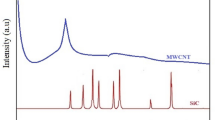Abstract
There has been an increase in interest of late regarding the properties of thermally sprayed WC-Co cermets with nanograin carbide particles. These powders have shown interesting properties in sintered components, giving high values of hardness (2200–2300 VHN) and improved wear properties. The method used for the processing for these materials—solution formation, spray drying and chemical conversion, rather than introduction of WC as solid particles to a molten binder—allows the formation of sub-100 nm WC particles as a hard second phase.
The work presented here examined the effect of composition on the microstructure and wear properties of some nanostructured WC-Co materials. WC-Co cermets with 8, 10, 12, and 15% Co binder phase were deposited using a Sulzer Metco hybrid DJ HVOF thermal spray system. Optimization of deposition conditions was necessary because of the unique morphology of the powders (thick-shelled hollow spheres) to produce dense consolidated deposits.
There is a higher degree of decarburization of the WC phase in the nanostructured materials compared with the conventional WC-Co. This dissolution of the hard phase is also noted to increase on decreasing binder phase content.
The nanostructured WC-Co coatings have a lower wear resistance compared with the conventional WC-Co for abrasive wear and small particle erosion. The abrasive wear resistance of these nanostructured materials was found to increase on decreasing cobalt binder content. This trend in abrasive wear resistance is consistent with studies on conventional sized cermets and is believed to be more dependent upon proportion of binder phase content than degree of decarburization for the materials studied. The small particle erosion resistance of the nanostructured coatings was found to increase on increasing cobalt content.
Similar content being viewed by others
References
B.H. Kear and L.E. McCandlish: “Chemical Processing and Properties of Nanostructured WC-Co Materials,” Nanostruct. Mater., 1993, 3, pp. 19–30.
L.E. McCandlish, B.H. Kear, and B.K. Kim: “Chemical Processing of Nanophase WC-Co Composite Powders,” Mater. Sci. Technol., 1990, 6, pp. 953.
K. Jia and T.E. Fischer: “Sliding Wear of Conventional and Nanostructured Cemented Carbides,” Wear, 1997, 203–204, pp. 310–18.
K. Jia and T.E. Fischer: “Abrasion Resistance of Conventional and Nanostructured Cemented Carbides,” Wear, 1996, 200, pp. 206–14.
M.R. Dorfman, B.A. Kushner, J. Nerz, and A.J. Rotolico: “A Technical Assessment of High-Velocity Oxygen-Fuel Versus High-Energy Plasma Tungsten Carbide-Cobalt Coatings for Wear Resistance” in Proceedings 12th International Thermal Spray Conference, I.A. Bucklow, ed., The Welding Institute, London, 1989, pp. 108.1–108.12
D.A. Stewart, A.H. Dent, S.J. Harris, A.J. Horlock, D.G. McCartney, and P.H. Shipway: “Novel Engineering Coatings with Nanocrystalline and Nanocomposite Structures by HVOF spraying,” J. Therm. Spray Technol., 1998, 7(3), pp. 422–23.
S. Usmani, S. Sampath, and H. Herman: “HVOF Processing of Nanostructured WC-Co Coatings and Their Properties,” J. Therm. Spray Technol., 1998, 7(3), pp. 429–30.
D.A. Stewart, P.H. Shipway, and D.G. McCartney: “Abrasive Wear Behavior of Conventional and Nanocomposite HVOF-sprayed WC-Co Coatings,” Wear, 1999, 225–229, p. 789.
Anon.: Diamond Jet Process Manual, Metco, Westbury, NY, 1991
A.D. Hewitt: “Technology of Oxy-Fuel Gas Processes. Part 2: Comparative Combustion Properties of Fuel Gases,” Weld Met. Fabr., 1972, 11, p. 382.
C. Verdon, A. Karimi, and J.-L. Martin: “A Study of High Velocity Oxy-fuel Thermally Sprayed Tungsten Carbide Based Coatings. Part 1: Microstructures,” Mater. Sci. Eng., 1998, A246, p. 11.
C.J. Li, A. Ohmori, and Y. Harada: “Formation of an Amorphous Phase in Thermally Sprayed WC Co,” J. Therm. Spray Technol., 1996, 5(1), pp. 69–73.
D.A. Stewart, P.H. Shipway, and D.G. McCartney: “Microstructural Evolution in Thermally Sprayed WC-Co Coatings: Comparison Between Nanocomposite and Conventional Starting Powders,” Acta Mater., 2000, 48, p. 1593.
S. Usmani, S. Sampath, D.L. Houck, and D. Lee: “Effect of Carbide Grain Size on the Sliding and Abrasive Wear Behavior of Thermally Sprayed WC-Co Coatings,” Trib. Trans., 1997, 40, p. 470.
S.F. Wayne and S. Sampath: “Structure/Property Relationships in Sintered and Thermally Sprayed WC-Co,” J. Therm. Spray Technol., 1992, 1, p. 307.
A.C. Bozzi and J.D.B. deMello: “Wear Resistance and Wear Mechanisms of WC-12Co Thermal Sprayed Coatings in Three-Body Abrasion,” Wear, 1999, 233–235, pp. 575–87.
S. Rangaswamy: “Metallurgical Characterization of Plasma Sprayed Tungsten Carbide Cobalt Carbide Coatings,” Ph.D. Thesis, State University of New York, Stony Brook, NY, 1987.
R.L. Mehan and J.R. Rairden: “Topical Report,” Dept. Energy, DOE/MC/23174-2913, June 1990.
Author information
Authors and Affiliations
Rights and permissions
About this article
Cite this article
Dent, A.H., DePalo, S. & Sampath, S. Examination of the wear properties of HVOF sprayed nanostructured and conventional WC-Co cermets with different binder phase contents. J Therm Spray Tech 11, 551–558 (2002). https://doi.org/10.1361/105996302770348691
Received:
Revised:
Issue Date:
DOI: https://doi.org/10.1361/105996302770348691




